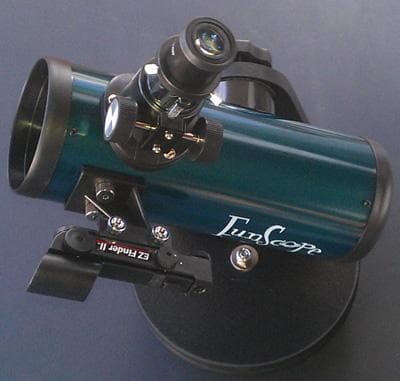
with David Fuller

Orion Funscope 76 review (Part 1)
When many well-meaning people get started in astronomy - or wish to encourage a youngster to do so - they think, "What is the least expensive / good scope I can get so I won't have spent too much in case it doesn't work out?" The problem with that mindset is that inexpensive scopes - though nowadays they have acceptable optics - usually have a host of other cost-cutting issues: Shaky tripods, poor finderscopes, and nearly impossible-to-use mounts that make pointing the telescope frustrating more than fun. Fortunately, a couple of manufacturers may have solved many of those "first telescope" problems. And one of them is by Orion Telescopes: Enter the Funscope 76mm.

About 2 years ago, I bought a Celestron Firstscope. It's one of those little tabletop Dobsonian type telescopes that is meant to be inexpensive yet provide decent views. And for it's size and price (I bought mine for $30, used), it's about impossible to beat. But not long after that, I realized that an Orion Funscope 76 probably would have been a better choice. But... they were $50 (then), today they are $60. But a week or so ago, Orion had them on sale for $40. Well, I wasn't going to pass THAT up - so I bought one. This, despite not needing it, and still owning the Celestron. But I wanted to be able to give a comparison to you. So here goes.
First, let's talk about the bad. It's not large aperture, at only 76mm. Furthermore, the focal length is just 300mm - that's only about 1 foot! What does that mean to you? Not very much light grasp at 76mm diameter, and difficulty achieving high magnification due to only being 300mm (divide eyepiece focal length into telescope focal length to get the magnification; for example 300mm / 20mm = 15x magnification). And lastly, the mirror is spherical; in laymans terms, that means not all of the light will focus well across the entire field of view that you can see - so at the outer edges of your eyepiece, stars will look like seagulls instead of points of light.
BUT....
With the bad comes the good. First, the price. At $60 regular price, that's STILL less expensive than even the least expensive 60mm refractors, which are smaller in aperture and usually on shaky tripods. The squat, table-top mount of the Funscope is quite sturdy and solid. Put it on a solid picnic table or car trunk, and you've got a solid, jiggle-free scope.
Second, that short focal length means that achieving high magnification may be difficult, but getting wide fields of view is easy! That spherical mirror may not give you pinpoint stars, but with a field of view of about 3 degrees with the 20mm eyepiece, you still have a good 1.5 to 2 degrees of decent-looking sky to see. And, with a wide field like that, finding and tracking objects is easier, because you have more visual "room" in the field of view to see and track as the Earth rotates.

And there's more good stuff. I don't know how Orion manages to get this scope made, sell it to us, and still make anything on it for $60. I mean, the included reflex finder alone - if bought separately - is $40 new! How do they include that AND a telescope AND eyepieces? I don't know. Celestron's Firstscope doesn't include any finder. That makes the Orion Funscope a better deal already! Now, the reflex sight is a "zero power" finder - meaning you look through a piece of plastic that reflects a small red dot when click on the power to it. By centering the red dot on the section of sky you want to see, you effectively 'aim' the scope this way.

But about those eyepieces. They're not half bad. Oh no, they're not Plossls - come on, 4-element Plossl eyepieces are $30 to $50 each normally. And the Celestron scope includes a Huygenian 20mm and a Ramsden 4mm - both 2-element EP's. AND, those ones aren't coated at all - just plain glass. The Orion ones, on the other hand, are the better 3-element eyepieces - whether they are Kellner or RKE style, I don't know, but what is clear is that they are fully coated! No, not the green (good) multicoatings of expensive eyepieces, but the purplish single-coating is there, which will increase what you can see through them. PLUS, the eyepieces have fold-up eyecups, so you can block stray light (if you don't wear glasses), or fold them down (if you do, to have sufficient eye-relief - or distance between your eye and the eyepiece lens).

I took a few pictures through the eyepieces, and it's amazing what can be seen through them. Certainly, focusing stars into pinpoints is far more demanding on optics, so the real test will be at night under the stars. But even just pointing my phone camera through the lens, I was taking crisp pictures - look at the paint that is flaking off of the phone wire insulator. That is from 100 feet away - AND through a screened window! (Remember, a reflector inverts the view and is reversed left to right.)
So far, I'm impressed.
Alright, what else does this little scope have? Well, compared to the Celestron Firstscope, it doesn't seem like much... until you dig a little deeper. I already mentioned the difference in eyepieces and inclusion of a finderscope - which took all of about 2 minutes to attach and align, by the way. When comparing the specs and the construction, it looks nearly identical. The mirrors, tube, focuser, mount - they all look like similar materials, if not identical in some cases. But look closer at the Orion:
- The focuser cap is a little heavier-duty plastic
- A better, more complete and understandable instruction manual
- The fit and finish of the mount is just a little nicer
- And importantly, there is a 1/4-20 socket underneath to allow attaching to a tripod
Say what? Yes, that's right: You don't even have to use this scope on a table. With a heavy duty (and by that, I mean an actual video-camera style) tripod that has a 1/4-20 threaded mount, you can put this telescope on top of it.

Now I tried this two ways: Once with a ridiculously small and flimsy tripod, and then again with my camera tripod (which is billed as a video tripod, but really is meant for a camera). With the smaller tripod the results were predictable; horrible swaying and vibrations - but - even with that, I could still focus on a distant telephone pole with the 10mm eyepiece. Using the camera tripod produce better results, but again, there was some vibrations - a 4 pound telescope on a tripod meant for 24 ounces just isn't a good fit.
Lesson? Use a table, or a VERY heavy duty tripod that can actually hold 5 or 6 pounds comfortably.
And on that note, I tried something interesting. An equatorial-mounted telescope aligns one axis with Earth's axis, so that tracking objects in the night sky only requires moving one motion on the telescope. Normally, on a table, this telescope would require two motions - up/down and left/right to account for Earth's rotation. "But wait a second!" I thought. "What if I tilt the tripod head so that the azimuth axis IS pointing towards the celestial pole, and aligned with the Earth's axis? Would that work?"
Can't hurt to try, right?
So I did. Tilting the tripod head to about 40 degrees (my latitude near Chicago IL), my camera tripod stayed steady with the 4 lbs scope, and the scope's axes still moved nicely even in the non-traditional orientation. Now, it remains to be seen how well this will work under practical night-sky conditions, but I am anxious to try. And the bearing surface in the azimuth section of the mount may not withstand doing this over long periods of time either. But for higher magnification applications - like viewing planets - it may prove to make it easier to track them.
I'll find out, and report back! That's my initial assessment of this truly "fun scope". Want to know what you can see with it? Check out Part 2 of my review.
